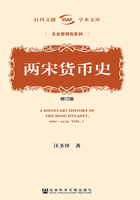
Abstract
Noted for its wide variety and prodigious quantity, currency in the Song Dynasty has long been a subject of keen interest to researchers in both general and economic history of ancient China, as well as scholars specializing in the Song Dynasty. Until this book, however, there has never been any scholarly work dedicated to the study of Song currency. This book looks closely at monetary policies, the production and distribution of copper and iron coins, and paper money, and the circulation of gold and silver during the Song dynasty, and addresses a number of significant theoretical issues. The result is a comprehensive overview of the general conditions of the production, circulation and regulation of currency during the Song Dynasty.
Overcoming the sense of mysteriousness and unknowability of the subject matter that has long hampered efforts to study Song currency, the author offers unconventional takes on the main features of currency circulation during the period, effects of the various prohibitions related to the production and circulation of coins in general and of copper coins in particular, the main characteristics of paper money, and the position of gold and silver relative to other forms of currency.
On monetary policies during this period, the author points out that the Song dynasty was unmatched throughout Chinese history in terms of the scope of coverage of official injunctions related to coins, including copper coins. While these injunctions helped keep the costs of production low and ensured abundant supply, they also led to an oversupply of money. A close link existed between money supply and fiscal policies, and paper money enjoyed relative independence, largely as a result of the fact that taxation receipts provided the basis for its credibility. However, the long-term policy of allowing the use of an admixture of notes and copper coins compromised the notes' value as a form of legal tender. On silver, the author points out that while the metal did function as a form of currency, it was not widely used as such during the Song dynasty.
The book, a distinct contribution to this field of research, would not be what it is had the author not benefited from the rich trove of past studies on the subject. His commitment and adherence to rigorous intellectual standards and scholarship requirements has ensured the quality of the final product.